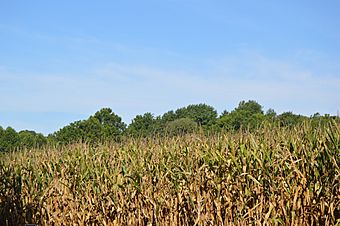Fairfield Plantation (Gloucester County, Virginia) facts for kids
|
Fairfield Plantation
|
|

Overview, planted in corn
|
|
| Nearest city | White Marsh, Virginia |
|---|---|
| Area | 220 acres (89 ha) |
| Built | 1692 |
| Built by | Lewis Burwell (1621–1653) |
| NRHP reference No. | 73002019 |
Quick facts for kids Significant dates |
|
| Added to NRHP | July 16, 1973 |
Fairfield Plantation was a large farm, called a plantation, in the 17th century Colony of Virginia. It was famous for growing tobacco. The Burwell family of Virginia owned this land from 1642 to 1787. Sadly, the main house burned down in 1897.
Today, Fairfield Plantation is an important archaeological site. This means experts are digging there to find clues about the past. They have found remains of the main house, homes for enslaved people, a big fancy garden, and the Burwell family's burial ground. Archaeologists David Brown and Thane Harpole from the Fairfield Foundation have led this research.
The Fairfield Manor House
The main house at Fairfield was built in 1694. It was made of brick and was very impressive for its time. An expert named Cary Carson called it "the most sophisticated classical house built in British North America to that date." It was designed to look like the grand homes of wealthy people in London, England.
The house had strong brick walls and a long porch, called a veranda, on the front. This veranda was 62 feet long and looked out over a large, beautiful garden. The house also had very big rectangular windows. It was one of the first homes in the colony to have a special type of roof called a hipped roof with dormer windows. Back then, most buildings were simpler, often built on wooden posts sunk into the ground.
Fairfield Plantation is recognized as a special historical place. It became a National Register of Historic Places listing on July 16, 1973. It was also named a Virginia Historic Landmark on February 20, 1973.
The Burwell Family and Fairfield
The land for Fairfield was first claimed by Lewis Burwell (1621–1653) on June 12, 1648. Lewis Burwell and his family moved to the area from nearby York County around 1651.
Growing the Plantation
The plantation grew bigger over time, and so did the number of enslaved people forced to work there. This happened especially when Lewis Burwell (1652-c.1710) (often called Lewis II) took over. He inherited land, important connections, and enslaved people from his family. Lewis II gained full control of the property after his mother passed away in 1677.
Fairfield was a very successful tobacco plantation. It was also a key place for trade along Carter's Creek. Its location was perfect, being only about half a day's travel from the new capital city of Williamsburg.
Life at Fairfield
Fairfield was at its busiest and most important during the first half of the 1700s. During this time, five different people managed the land. They all worked to keep the plantation making money from farming. They also tried growing different crops and raising many cattle and other animals.
However, by the end of the 1700s, the Burwell family faced serious money problems. They owed a lot of money. Many enslaved people who worked on the plantation were sold to other plantations further west and south. As parts of the land were sold to pay debts, Fairfield became much smaller. The remaining enslaved workers were then focused on the smaller area around the main house. We don't know much about what happened to the enslaved people of Fairfield when the plantation was sold in 1787. However, some were bought by neighbors and might have stayed in the area.
Fairfield Owners Through Time
Here's a quick look at who owned Fairfield Plantation over the years:
| Years Owned | Owner |
| 1648-1653 | Lewis Burwell (1621–1653) |
| 1653-1665 | Lucy Higginson Burwell and William Bernard |
| 1665-1675 | Lucy Higginson Burwell Bernard and Philip Ludwell |
| 1675-1710 | Lewis Burwell (1652-c.1710) |
| 1710–1721 | Nathaniel Burwell (1680–1721) |
| 1721–1734 | Robert “King” Carter (managed the estate) |
| 1734–1756 | Lewis Burwell IV/I (1710–1756) |
| 1756–1779 | Lewis Burwell (1711–1756) (1737–1779) |
| 1779–1787 | Lewis Burwell (born 1764) |
| 1787–1816 | Robert Thruston (1759–1816) |


